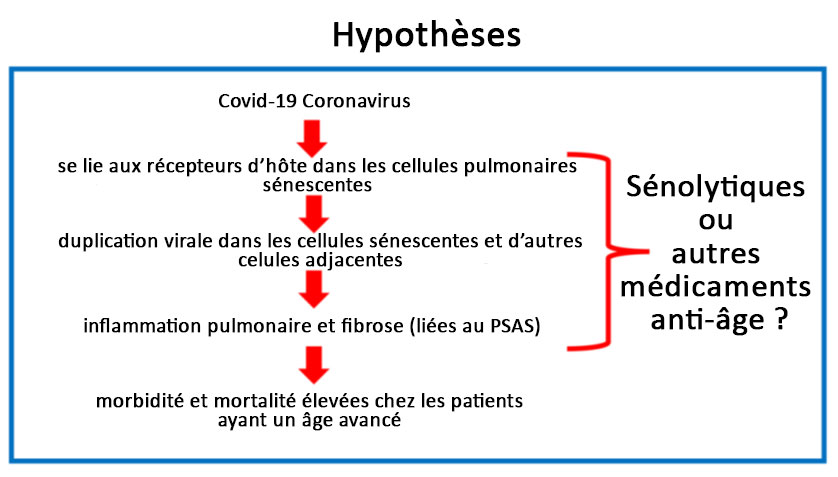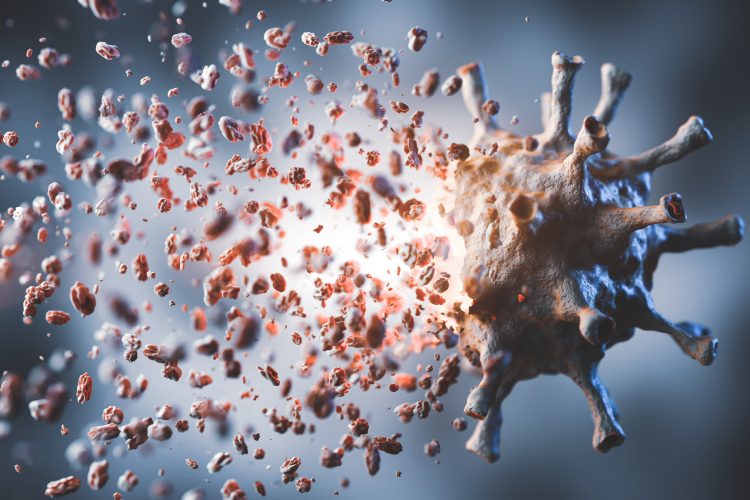- Qu’est-ce qu’un médicament antivieillissement et/ou sénolytique?
- À quel moment les cellules sénescentes deviennent-elles une menace?
- Qu’est-ce que le vieillissement chronologique et pourquoi s’y attarder?
- Quels sont les mécanismes d’action de la Covid-19?
- Les hypothèses
- Les implications et/ou impacts des composés naturels et les médicaments antivieillissement comme prévention
Mettant de côté toutes opinions personnelles et émotions en lien avec la Covid-19 et en tant que chercheure dans le domaine du vieillissement, l’article scientifique publié par Sargiacomo et al., 2020; Covid-19 and chronological aging : senolytics and other anti-aging drugs for the treatment or prevention of corona virus infection? (qui peut se traduire comme suit : La Covid-19 et l’âge chronologique : sénolytiques et autres médicaments anti-âge pour le traitement ou la prévention de l’infection par le coronavirus?) a définitivement attiré mon attention! Cet article était destiné à la communauté scientifique pour sensibiliser à l’idée d’utiliser des médicaments antivieillissement/sénolytiques dans le traitement de ce qui semble être notre ennemi actuel, la Covid-19. Cet article explore donc l’idée de composés contre le vieillissement comme prévention pour les maladies, incluant la Covid-19.
Qu’est-ce qu’un médicament antivieillissement et/ou sénolytique?
Avant de sauter directement dans les détails de l’article mentionné ci-haut, je vais commencer en définissant ce type de médicaments du mieux que je peux, avec un peu de jargon scientifique, pour ne pas vous perdre avant d’en arriver aux résultats juteux! Les médicaments ou produits antivieillissement sont exactement comme leur nom l’indique; des molécules qui agissent sur les processus spécifiques au vieillissement. La partie intéressante est que certaines de ces molécules sont des composés isolés de sources naturelles! Vous avez probablement déjà entendu parler de certaines d’entre elles – le resvératrol, la caféine, la spermidine, etc. Vous trouverez plus de détails concernant ces composés naturels à travers le blogue de Vitoli :
- Le resvératrol : comment réagir à un danger de mort!
- Polyphénols d’olives et les produits Vitoli – article 1 : le vieillissement primaire
- Polyphénols d’olives et les produits Vitoli – article 2 : les bénéfices
- Les polyphénols d’olives protègent du vieillissement (article 1 de 2)
- Les polyphénols d’olives augmentent l’espérance de vie? (article 2 de 2)
Plus précisément, les médicaments sénolytiques sont en quelque sorte des médicaments antivieillissement puisqu’ils visent les cellules sénescentes responsables d’un grand nombre de dysfonctions reliées au vieillissement (cellules qui ne se divisent plus ou qui ne sont plus fonctionnelles) et s’assurent qu’elles sont correctement éliminées (appelé apoptose; mort cellulaire programmée ainsi que d’autres programmes de maintenance cellulaire).
À quel moment les cellules sénescentes deviennent-elles une menace?
L’apoptose (la mort cellulaire programmée) est un programme de maintenance vraiment efficace qui, comme pour l’usure normale de toute machine, retire les boulons et les écrous rouillés ou brisés avant qu’ils ne causent de problèmes à la machine. Les cellules ont leur propre durée de vie et de cycle/phase. Dans un système complètement fonctionnel, lorsqu’il survient un dysfonctionnement, les programmes d’entretiens ciblent ces cellules afin de les empêcher de se reproduire/dupliquer et les éliminent.
Quand les cellules sortent de leur cycle de croissance et arrêtent de se diviser, ils sont appelés les cellules quiescentes. L’état cellulaire quiescent est un domaine d’intérêt pour la recherche antivieillissement. C’est ici que les cellules ont accès à l’information environnementale et s’adaptent en conséquence pour survivre et pour réintégrer le cycle de division/reproduction basé sur l’adaptation d’un stress spécifique (incluant le vieillissement). Même si cette information n’est pas significative pour cet article en particulier, ce sera définitivement un sujet qui sera couvert plus tard sur le blogue de Vitoli. Selon moi, c’est un morceau d’information qui devrait être mentionné lorsque nous expliquons la durée de vie/cycle d’une cellule parce que c’est un aspect sur lequel les chercheurs travaillent en médecine de longévité.
Les cellules sénescentes qui quittent définitivement le cycle cellulaire (contrairement aux cellules quiescentes) sont biologiquement arrêtées afin de limiter la croissance dysfonctionnelle/cancéreuse. Dû à certains facteurs, il arrive parfois que les systèmes d’entretien biologique les éliminent et parfois, ils sont simplement gardés sous surveillance. Ces cellules s’accumulent naturellement tout au long du processus de vieillissement. Alors, plus nous vieillissons, plus il y a de cellules sénescentes. Malgré le fait que les cellules sénescentes aient leur rôle, le problème est que ces cellules s’accumulent dans le corps, « …avec l’âge, ceci conduit à une inflammation accrue due à un phénotype sécrétoire associé à la sénescence (PSAS). Ce phénotype qui inclut plusieurs cytokines favorise les tumeurs et peut épuiser le réservoir de cellules immunitaires dans le corps. » (Traduction libre) (Thoppil & Riabowol, 2020). Donc, si les mécanismes de maintenance ne détruisent pas les cellules sénescentes et que ces cellules s’accumulent, avec le temps, elles surproduiront des molécules inflammatoires, ce qui affaiblira le système immunitaire et le corps sera plus sensible aux diverses maladies.
Qu’est-ce que le vieillissement chronologique et pourquoi s’y attarder?
Dû au fait que le coronavirus affecte plus facilement les personnes vieillissantes, ces scientifiques ont choisi de se concentrer sur l’association de la Covid-19 et le vieillissement chronologique humain (terme scientifique utilisé pour définir l’âge depuis la date de naissance). Avec les résultats des statistiques provenant des CDC aux États-Unis (Center for disease control) déjà au mois de mars 2020, nous pouvions voir que les gens âgés de 85 ans et plus présentaient le taux de mortalité le plus élevé (10-27%) et que ce taux diminuait en même temps que les tranches d’âges diminuaient. Puisque les personnes âgées sont plus susceptibles de contracter ou de succomber à ce virus, il pourrait y avoir une association directe à un mécanisme spécifique ou une voie privilégiée par le virus chez les populations âgées. Ce qui, avec du recul, semble être une question que nous aurions due nous poser, étant donné les informations que nous savions tous, simplement en écoutant les nouvelles!
Quels sont les mécanismes d’action de la Covid-19?
Étant donné que les populations les plus âgées sont plus susceptibles d’avoir un plus grand nombre de cellules sénescentes (tel que mentionné plus haut), les chercheurs ont proposé que le virus pouvait agir sur ces mécanismes. Même s’il reste encore des recherches à faire sur les spécificités de la Covid-19 et de ces mécanismes d’action, les auteurs de cet article ont observé que la Covid-19 agit principalement sur deux facteurs majeurs; CD26 et ACE-2 (enzyme de conversion de l’angiotensine 2). Un fait intéressant : « La CD26 et le système d’angiotensine présentent des associations avec la sénescence. » (Traduction libre) (Sargiacomo et al., 2020).
Sargiacomo et ses collaborateurs suggèrent que les médicaments sénolytiques comme la chloroquine et ses dérivés (ex. : Hydroxychloriquine et Azithromycine) peuvent agir sur la sénescence en passant par le PSAS de la Covid-19 de la même manière qu’ils le font pour d’autres virus et maladies (Zika, Ebola, Fibrose kystique, syndrome de Sjogren, etc.). Compte tenu de l’histoire de ces médicaments pour d’autres virus et maladies, il y a beaucoup de potentiel, mais encore beaucoup de recherche à faire avant de déterminer la solution la plus optimale.
Leur recherche a aussi suggéré que la quercétine avait, elle aussi, des propriétés sénolytiques. Il a été démontré que la quercétine empêcherait l’attachement initial du virus sur les cellules sénescentes avec l’aide du récepteur ACE-2 (Smith et al., 2020). Ce qui fait que la quercétine soit si intéressante, c’est qu’elle est disponible naturellement par des sources alimentaires qui sont facilement accessibles. Ceci signifie que votre aide sénolytique contre le virus pourrait très bien se trouver dans votre réfrigérateur ou votre garde-manger au moment que vous lisez ces lignes!
Pour en apprendre davantage sur la quercétine et ses multiples sources alimentaires naturelles, consultez l’article Quercétine et Coronavirus : mangez-en si cela vous intéresse! qui est un bon départ sur le sujet! Assurez-vous aussi de jeter un œil à la recette Soupe au thé vert, dinde et légumes riches en quercétine qui intègre naturellement ce composé.
Les hypothèses
Selon les résultats observés, Sargiacomo et ses collaborateurs ont proposé l’hypothèse selon laquelle la Covid-19 cible et infecte les cellules pulmonaires sénescentes (qui sont abondantes chez nos populations vieillissantes), qui se dupliqueront et causeront de l’inflammation liée au PSAS (mentionné précédemment), qui compromettront finalement le système immunitaire. Donc, ce qu’ils ont proposé, c’est que les sénolytiques ou autres médicaments antivieillissement peuvent activer l’apoptose et les mécanismes d’entretien de manière à ce que les cellules sénescentes soient éliminées avant ou durant l’infection pour ainsi contenir la propagation interne du virus et accroître le potentiel immunitaire. N’est-ce pas incroyable ?! Malheureusement, plus de recherches doivent être faites, tout comme des études de cas, pour transformer cette hypothèse en quelque chose de plus concluant.

(Sargiacomo et al., 2020)
Les implications et/ou impacts des composés naturels et les médicaments antivieillissement comme prévention
En résumé, les composés antivieillissement ont beaucoup de potentiels dans de multiples domaines en dehors de la longévité. Même si plus de recherches doivent être effectuées, la prémisse de certaines hypothèses et résultats actuels laisse entrevoir un avenir optimiste. Le facteur important que j’aimerais mettre de l’avant dans cet article à travers les diverses recherches qui sont présentement en cours, c’est qu’il y a une possibilité que certains médicaments sénolytiques/antivieillissement qui ont fonctionné pour les virus dans le passé peuvent très bien fonctionner pour ce virus. Un autre point que j’aimerais souligner est le potentiel des médicaments naturels et/ou traditionnels sénolytiques et antivieillissement dans ce domaine d’étude! Pour plus d’informations sur d’autres recherches concernant les produits naturels et le coronavirus, je vous invite à lire l’article suivant qui est aussi disponible sur le blogue de Vitoli : Coronavirus et les produits naturels; l’espoir de nouveaux antiviraux.
Mon conseil personnel lié à une mesure préventive dans le but d’augmenter l’immunité contre le virus est simple : ayez une alimentation saine et équilibrée (une diète qui comprend préférablement des composés naturels anti-âge et des superaliments), restez actif, conservez une attitude positive et reconnaissante en plus de trouver des manières de diminuer le stress chronique qui correspondront le mieux à votre style de vie. Nous sommes tous ensemble dans cette situation et nous espérons tous voir la lumière au bout de ce tunnel très bientôt!
J’espère que vous avez apprécié cet article! Au plaisir de vous transmettre d’autres textes pertinents sur divers sujets de la santé. Pour toutes questions ou commentaires, écrivez-nous à info@vitoli.ca.
Autres articles suggérés :
- Ma mère et le SARS-Cov-2
- Un excellent Virus
- L’Empire contre-attaque
- I have a dream…
- D’Aristote à la Covid-19
- La chimère et le virus… ou sur l’origine du SARS-Cov-2
Références:
- Sargiacomo C, Sotgia F, Lisanti MP. COVID-19 and chronological aging: senolytics and other anti-aging drugs for the treatment or prevention of corona virus infection?. Aging (Albany NY). 2020;12(8):6511-6517. doi:10.18632/aging.103001
- Thoppil H, Riabowol K. Senolytics: A Translational Bridge Between Cellular Senescence and Organismal Aging. Front Cell Dev Biol. 2020;7:367. Published 2020 Jan 22. doi:10.3389/fcell.2019.00367
- National Center for Biotechnology Information (2020). PubChem Compound Summary for CID 2719, Chloroquine. Retrieved August 12, 2020 from https://pubchem.ncbi.nlm.nih.gov/compound/Chloroquine.
- van Deursen JM. The role of senescent cells in ageing. Nature. 2014;509(7501):439-446. doi:10.1038/nature13193
- Fontana L, Partridge L, Longo VD. Extending healthy life span–from yeast to humans. Science. 2010;328(5976):321-326. doi:10.1126/science.1172539
- Hansel C, Jendrossek V, Klein D. Cellular Senescence in the Lung: The Central Role of Senescent Epithelial Cells. Int J Mol Sci. 2020;21(9):3279. Published 2020 May 6. doi:10.3390/ijms21093279
- Burton DG, Krizhanovsky V. Physiological and pathological consequences of cellular senescence. Cell Mol Life Sci. 2014;71(22):4373-4386. doi:10.1007/s00018-014-1691-3
- Mani JS, Johnson JB, Steel JC, et al. Natural product-derived phytochemicals as potential agents against coronaviruses: A review. Virus Res. 2020;284:197989. doi:10.1016/j.virusres.2020.197989
- Gorrell MD, Gysbers V, McCaughan GW. CD26: a multifunctional integral membrane and secreted protein of activated lymphocytes. Scandinavian Journal of Immunology. 2001 Sep;54(3):249-264. DOI: 10.1046/j.1365-3083.2001.00984.x.
- Tanaka T, Narazaki M, Kishimoto T. IL-6 in inflammation, immunity, and disease. Cold Spring Harb Perspect Biol. 2014;6(10):a016295. Published 2014 Sep 4. doi:10.1101/cshperspect.a016295






